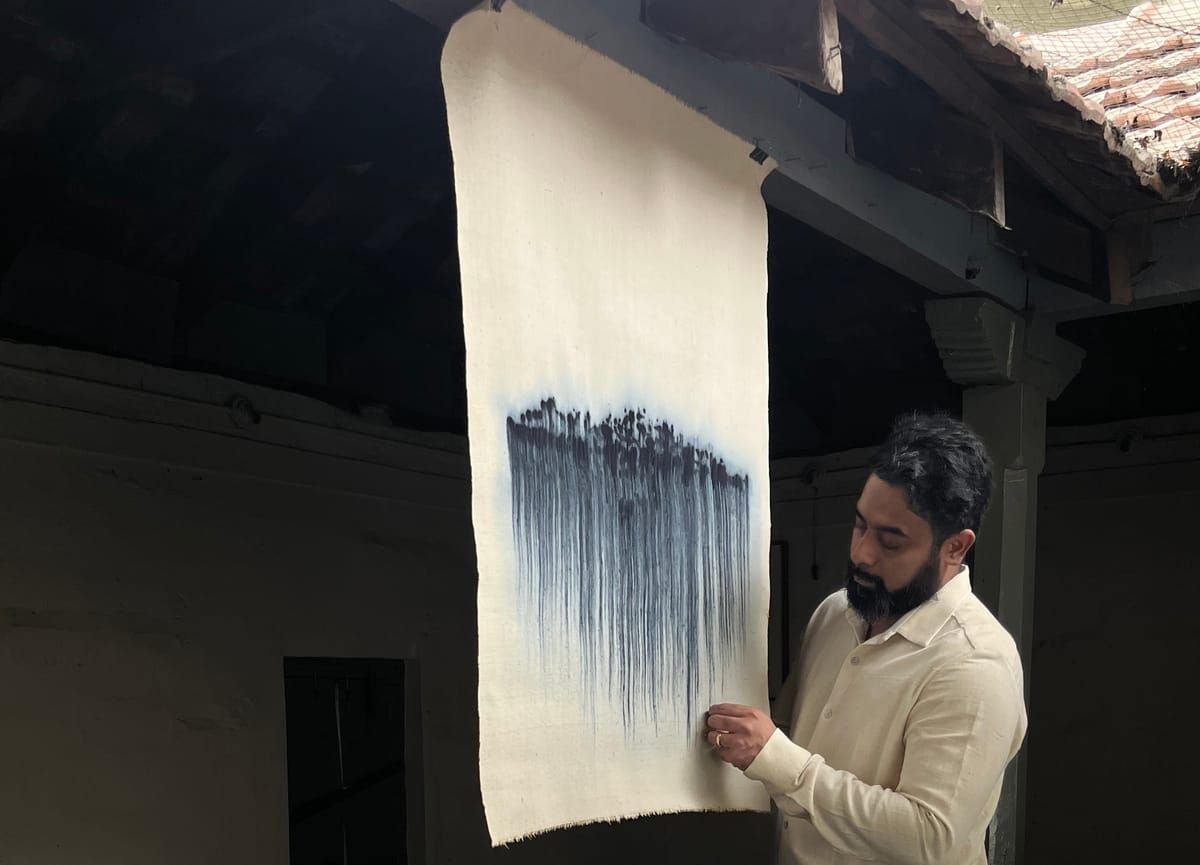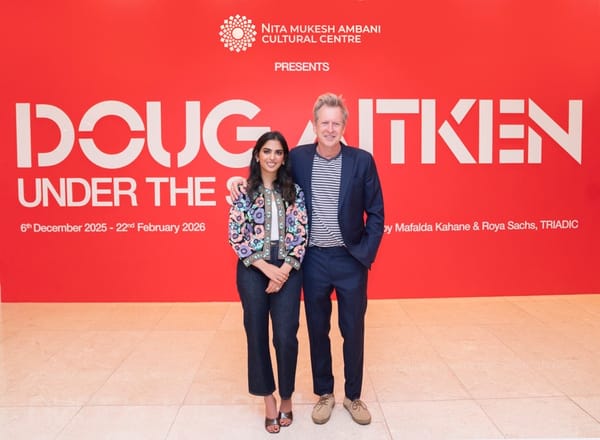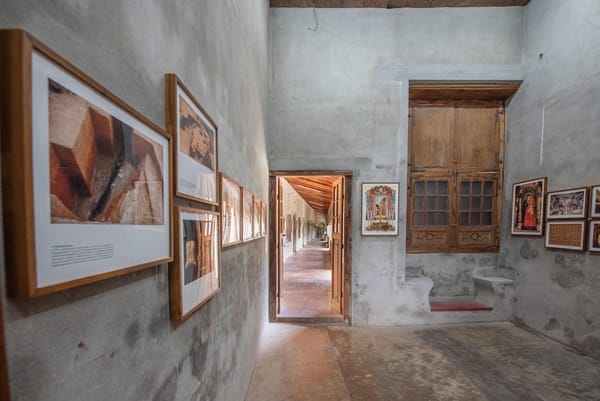From Threads to Indigo: The Artistic Journey of Abishek Ganesh Jayashree
Abishek Ganesh Jayashree, known as Kaimurai, blends organic forms and metaphysical energy in his art, using natural indigo and inspired by South Indian traditions, rituals, and Carnatic music to create a unique and meditative visual experience.

Abishek Ganesh Jayashree, known by his artistic identity Kaimurai, is an emerging artist whose work bridges the realms of the physical and metaphysical. Born in 1984 and a graduate of the National Institute of Fashion Technology (NIFT), Abishek initially carved a successful career in the apparel industry, leading design for prominent brands. However, his true calling lay elsewhere. Inspired by the natural beauty of the Western Ghats, ancient South Indian art, rituals, architecture, and Carnatic music, Abishek transitioned to a full-time art practice.
His art, characterized by the use of natural indigo, embodies a dialogue between organic forms and the flow of energy. Through repeated markings, ranging from fine strokes to bold brush strokes, Abishek captures the raw energy and inherent vibrations often buried beneath the chaos of daily life. His work is a meditative process, an interaction between the physical and metaphysical, where his hands take control, creating markings that reflect both calmness and aggression.

Abishek's notable solo exhibitions include 'Driggnita' at Bikaner House by Blueprint12 (2024), 'Divine Blue' at Kaash Foundation Bangalore (2022), and 'Shadjam' at Blueprint12 (2021). He has also participated in esteemed group displays such as 'Sutr Santati' at Melbourne Museum (2023), 'Conjunctions of the Sphere' curated by Girish Shahane at Bikaner House (2023), and exhibitions at NGMA, Mumbai (2023). His presence at Art Mumbai 2023, the Delhi Contemporary Art Week (2022 and 2023), and the India Art Fair (2023, 2024) has further cemented his reputation in the art world.
Living and working in Bangalore, Abishek continues to push the boundaries of his artistic expression, intertwining the physical with the spiritual, and the ancient with the contemporary.

Serenade Team: Can you share the story behind your transition from the apparel industry to becoming a full-time artist? What motivated this shift?
Abishek Ganesh Jayashree: I began my career in Fashion and Textile Design for the apparel industry at an early age, interning at an export-oriented company when I was 20 and joining the same company at 21. Throughout my 15-16 years in the industry, I was constantly learning and researching. My travels and interactions with experts enriched my knowledge.
The transition to my current artistic pursuit was not due to dissatisfaction with corporate life. I was doing well in my career. The shift occurred when I decided to delve into indigo pigment research and handmade textiles because of my fascination with denim. Before attending NIFT, I experimented with a unique stroke and mark-making process in my artwork, which resurfaced during my research and travels. These experiences, combined with memories from my upbringing, led me to focus on my current artistic practice.
ST: Your work is deeply inspired by the Western Ghats, Ancient South Indian art, rituals, architecture, and Carnatic music. How do these elements converge in your creative process?
AGJ: These elements are deeply rooted in my early life experiences. Growing up in a humble household near Mangalore and later in Madras, I was immersed in temple visits, daily poojas, trips to my native place, and the strong influence of Carnatic music, as my father practiced it. These day-to-day rituals and my innate curiosity shaped my artistic expression, blending my upbringing with my own creative fantasies.

ST: Natural indigo plays a central role in your artwork. What drew you to this particular material, and how does it enhance your artistic expression?
AGJ: In the fashion industry, I encountered natural dyes through artisans, though my brands didn't use them. The colour blue, and indigo in particular, has always fascinated me and holds a spiritual significance. Initially, I didn't plan for indigo to become my primary pigment, but it naturally did. I feel indigo chose me, serving as a spiritual material that enhances my ritualistic artistic process.
ST: Your use of repeated markings is both calm and aggressive. How do you balance these contrasting qualities in your compositions?
AGJ: My work is a ritualistic process. I work on the floor, wetting the fabric or paper before starting, similar to how kolams are created outside houses or temples. I apply my indigo concoction to the wet surface and make fine lines with a stick. These lines reflect my thoughts and emotions at the moment, sometimes calm, sometimes aggressive. By the end, the process brings me a sense of peace.

ST: What advice would you give to aspiring artists who are looking to transition from a different career path into the world of art?
AGJ: As an accidental artist, I didn’t choose to change my path. My advice to aspiring artists is to enjoy your work so much that even without financial gain or recognition, you would still be passionate enough to do it 24 hours a day.

ST: How do you see the relationship between the physical and metaphysical evolving in your future works?
AGJ: When I start my work, I gradually lose myself in the metaphysical realm. Carnatic music aids this process, often playing the Veena or guitar to trigger this state, or even a Tambura in the background. Certain smells also contribute. My future works will continue to revolve around these elements, blending physical materials with metaphysical experiences. I may explore collaborative physical performances, but that idea is still evolving.

ST: Congratulations on being awarded the prestigious Artist in Residence at the Australian Tapestry Workshop! Can you share your experiences during the residency, particularly how the time in Australia and the interactions with students, professors, curators, and researchers influenced your work and artistic perspective?
AGJ: During my Artist in Residence program at the Australian Tapestry Workshop (ATW), I was also awarded the Irene Davies International Scholarship and the Hancock Fellowship, which included a solo exhibition in Melbourne. Introduced to Sophie Travers by Lavina Baldota through her show Sutr Santati, I had given a talk at the symposium, providing insight into my practice.
The residency began with an exhibition at the ATW gallery, featuring works made in India and two key pieces created on tapestries woven specially for me by the workshop. These new materials allowed for unique experimentation. The folded works resembled temple deities or small shrines, drawing parallels with ancient Aboriginal Australian culture, which shares similarities with Indian traditions.

During my month in Australia, I travelled and gave lectures at the University of New South Wales (Sydney), Artisan (Brisbane), and the Hancock Fellowship lecture at ATW Melbourne. I engaged with senior Asian art curators from major galleries and spent quality time discussing my work with curators, professors, researchers, and PhD students, learning a great deal from these interactions.
The Hancock Fellowship lecture at ATW Melbourne, which marked the end of the residency, featured a discussion and interview by Padmini Sebastian from Melbourne University. I also met artist and ATW board member David Sequeira. Sophie Travers, the CEO and Director of ATW, greatly facilitated my engagement with Australia's art and creative community leaders.
I look forward to future meaningful exchanges and being part of ongoing dialogues on art and culture between India and Australia.





